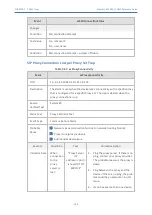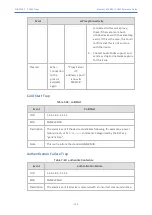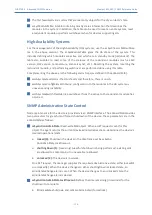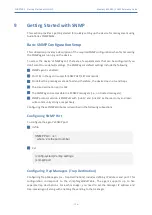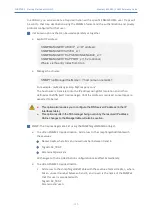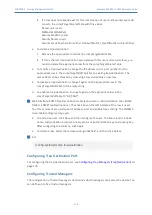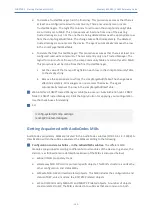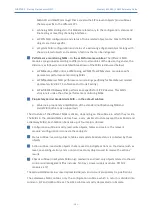
CHAPTER 9 Getting Started with SNMP
Mediant 800 SBC | SNMP Reference Guide
ii.
If a row does not already exist for this combination of user and SecurityLevel, add
a row to the snmpTargetParamsTable with this values:
Name=usm<user>
MPModel=3(SNMPv3)
SecurityModel=3 (usm)
SecurityName=<user>
SecurityLevel=M, where M is either 1(noAuthNoPriv), 2(authNoPriv) or 3(authPriv)
●
To delete a trap destination:
i.
Remove the appropriate row from the snmpTargetAddrTable.
ii.
If this is the last trap destination associated with this user and security level, you
can also delete the appropriate row from the snmpTargetParamsTable.
●
To modify a trap destination, change the IP address and or port number for the
appropriate row in the snmpTargetAddrTable for an existing trap destination. The
same effect can be achieved by removing a row and adding a new row.
●
To disable a trap destination, change TagList on the appropriate row in the
snmpTargetAddrTable to the empty string.
●
To enable a trap destination, change TagList on the appropriate row in the
snmpTargetAddrTable to "AC_TRAP".
■
Web Interface: SNMP Trap Destinations table (Setup menu > Administration tab > SNMP
folder > SNMP Trap Destinations). The check box on the left indicates if the row is used.
The three columns are used to set IP address, port and enable trap sending. The SNMPv3
Users table configures trap users.
●
To add a trap user: Click New, and then configure the user. The five columns include
name, authentication protocol, privacy protocol, authentication key and privacy key.
After configuring the columns, click Apply.
●
To delete a row: Select the corresponding index field, and then click Delete.
■
CLI:
(config-system)# snmp trap-destination
Configuring Trap Destination Port
For configuring the trap destination port, see
Configuring Trap Managers (Trap Destination)
Configuring Trusted Managers
The configuration of trusted managers determines which managers can access the device. You
can define up to five trusted managers.
- 178 -





